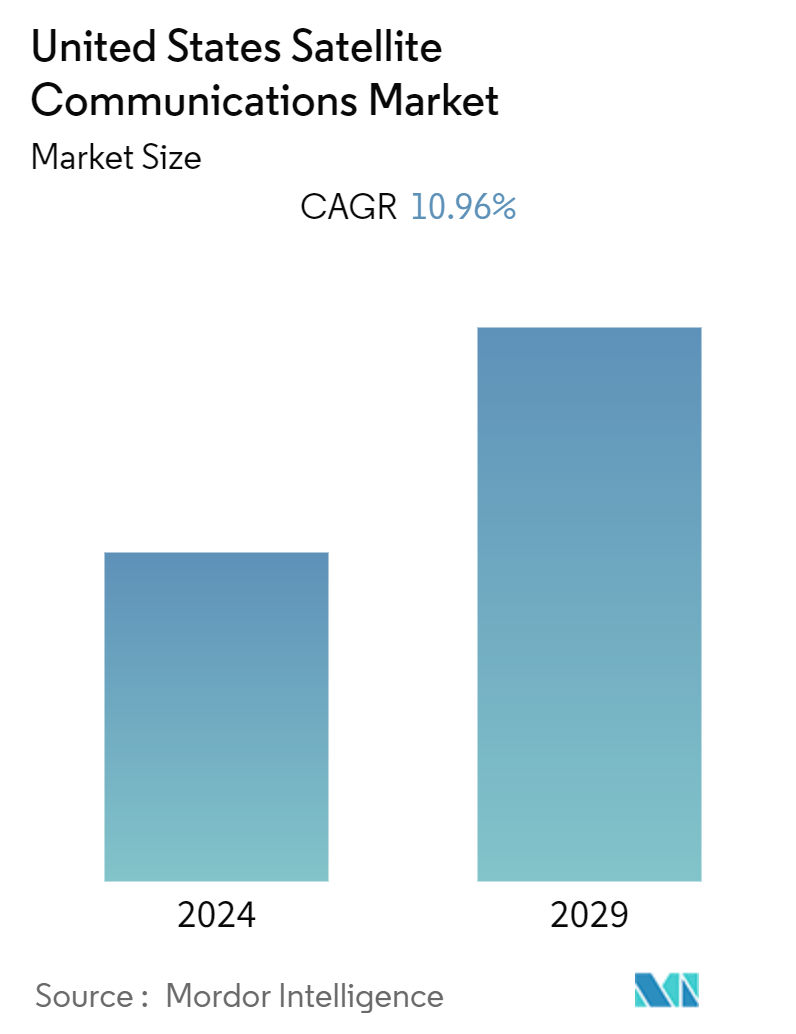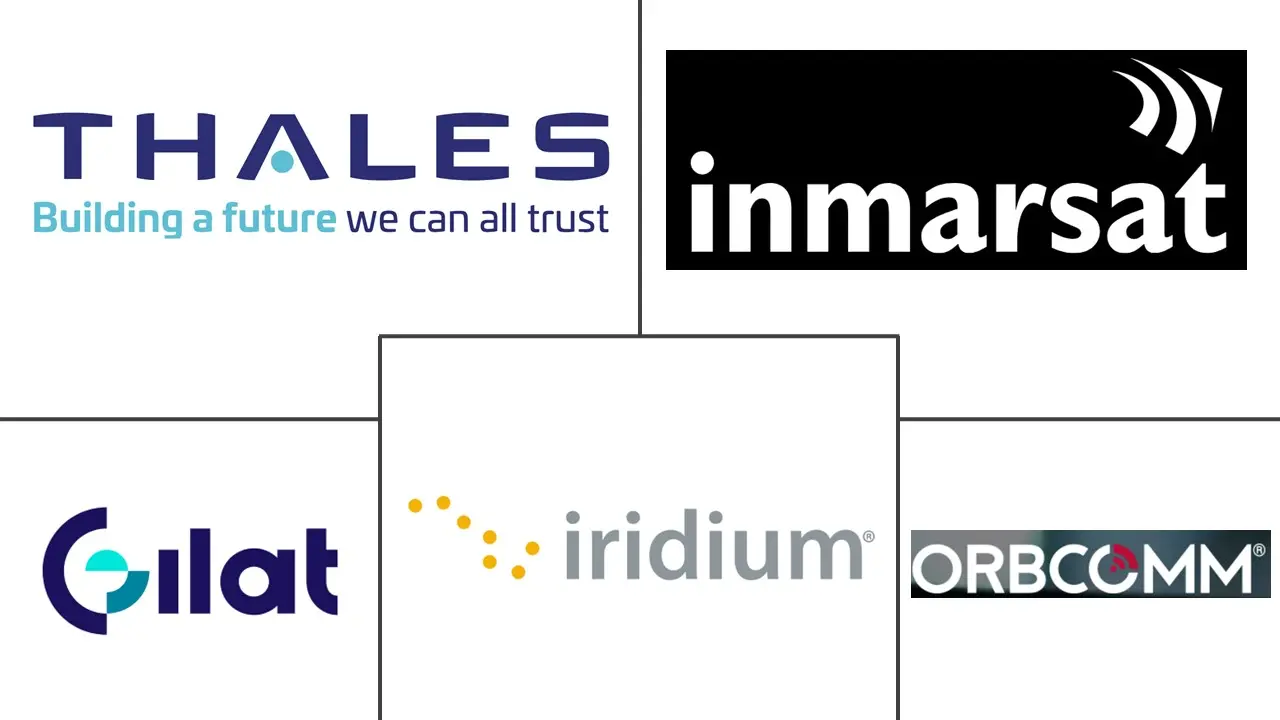Market Size of United States Satellite Communications Industry

| Study Period | 2019 - 2029 |
| Base Year For Estimation | 2023 |
| Forecast Data Period | 2024 - 2029 |
| Historical Data Period | 2019 - 2022 |
| CAGR (2024 - 2029) | 10.96 % |
| Market Concentration | Medium |
Major Players
*Disclaimer: Major Players sorted in no particular order |
United States Satellite Communications Market Analysis
The United States Satellite Communications Market is expected to register a CAGR of 10.96% during the forecast period.
Satellite communication is used for various applications across industries, such as media broadcasting, an extension of broadband coverage, 5G communications systems, integration and convergence of diverse wired and wireless technologies, earth observation, defense and security, and surveillance applications.
- The demand for broadband communications remains strong and is not necessarily geographically restricted. Such demands include connectivity requirements for users on aircraft, ships, and vehicles (including first responders) operating in fixed places and while in motion. These three platforms require constant connectivity along their travel itineraries, frequently passing through underserved sections of major metropolitan centers and less heavily inhabited areas. Such developments are projected to aid in the market's growth under consideration.
- Changes in satellite communications and telecommunications and computer systems advancements have created new opportunities in the sector's innovative areas. As industrial production facilities and mining operations expand into more inhospitable terrains, the need for efficient wireless connections via terrestrial and satellite communications grows.
- Satellite IoT applications can be found in various industries, ranging from the marine market to machine-to-machine (M2M) applications in transportation, agriculture, oil and gas, utilities, and construction, among many others. For instance, to better understand how satellite IoT is employed in the heavy equipment business.
- Several of the most extensive heavy equipment Original Equipment Manufacturers (OEMs) use Iridium's satellite IoT solutions to monitor and manage deployed assets remotely. Kobelco Construction Machinery (KCM), for example, recently collaborated with Iridium to incorporate Iridium's two-way satellite communications into its hydraulic excavator machinery, heavy equipment, and remote asset management platform. KCM equipment now has genuinely worldwide coverage for the first time due to the integration of Iridium IoT services.
- Direct broadcasting or satellite television has become a significant form of distribution for television content. The broad and controllable coverage areas and much larger bandwidths enable more channels to be broadcast, making satellite television very attractive. But the main drawback is that satellites cannot transmit very high-powered signals, and combined with the path loss from geostationary orbit; the signal levels are low. This indicates that directive antennas must provide sufficient gain while receiving signals from only one satellite. Several satellites could be visible from one location and broadcast on the same frequencies.
- A parabolic reflector antenna can meet these needs and has the added advantage that it would not be as long as a Yagi for an equivalent level of gain and directivity. The parabolic reflector antenna is often used as a broadcast satellite receive antenna. A parabolic reflector antenna realizes high gain and low sidelobe by converting the spherical wave radiated by a primary radiator to the plane wave.
- On the flip side, Cybersecurity has become a major concern for satellite communication as launching a satellite to transmit data is compassionate. Further, the challenge lies in the negative impact that such cybersecurity threats can potentially make, as the vulnerabilities are mission-critical. The mission-critical vulnerabilities exposed to cybersecurity threats include the launch systems, communications, telemetry, tracking and command, and mission completion. The over-dependency of satellite communication on secure cyber capabilities across the satellite's lifespan makes it a serious concern, hindering its adoption.
United States Satellite Communications Industry Segmentation
Satellite communication is data transmission from one location to another using a communication satellite in orbit around the Earth. A communication satellite is a man-made spacecraft that sends a signal via a transponder by establishing a channel between the transmitter and the receiver at separate Earth locations.
The United States satellite communications market is segmented by type ( ground equipment, services), by platform (portable, land, maritime, airborne), by end-user vertical (maritime, defense and government, enterprises, media and entertainment).
The market sizes and forecasts are provided in terms of value (USD) for all the above segments.
| By Type | |
| Ground Equipment | |
| Services |
| By Platform | |
| Portable | |
| Land | |
| Maritime | |
| Airborne |
| By End-user Vertical | |
| Maritime | |
| Defense and Government | |
| Enterprises | |
| Media and Entertainment | |
| Other End-user Verticals |
United States Satellite Communications Market Size Summary
The United States satellite communications market is poised for significant growth, driven by its diverse applications across various sectors such as media broadcasting, broadband expansion, 5G systems, and defense. The market's expansion is fueled by the increasing demand for reliable connectivity in remote and underserved areas, including maritime and vehicular platforms. Innovations in satellite IoT applications are further enhancing connectivity in industries like transportation, agriculture, and construction. The integration of advanced satellite communication technologies, such as Iridium's solutions in heavy equipment, exemplifies the sector's commitment to providing global coverage and efficient asset management. However, challenges such as cybersecurity threats and the need for secure communication channels remain critical concerns that could impact market adoption.
Government initiatives and investments, particularly in the maritime sector, are expected to bolster the market's growth. The Bipartisan Infrastructure Law and contracts like the one awarded to Inmarsat Government by the U.S. Navy highlight the strategic importance of satellite communications in enhancing national infrastructure and defense capabilities. The market is characterized by a semi-consolidated landscape with key players like Iridium Communications, ORBCOMM, and Viasat actively pursuing strategic partnerships and product innovations. Recent developments, such as Viasat's contract with the U.S. Marine Corps and SpaceLink's collaboration with DARPA, underscore the ongoing efforts to integrate commercial and military satellite networks. These initiatives, coupled with substantial government defense spending, are anticipated to create lucrative opportunities for market players to develop and deploy advanced satellite communication solutions.
United States Satellite Communications Market Market Size - Table of Contents
-
1. MARKET INSIGHTS
-
1.1 Market Overview
-
1.2 Industry Attractiveness - Porter's Five Forces Analysis
-
1.2.1 Bargaining Power of Buyers
-
1.2.2 Bargaining Power of Suppliers
-
1.2.3 Threat of New Entrants
-
1.2.4 Threat of Substitutes
-
1.2.5 Intensity of Competitive Rivalry
-
-
1.3 Industry Value Chain Analysis
-
1.4 Assessment of the Impact of COVID-19 on the Market
-
-
2. MARKET SEGMENTATION
-
2.1 By Type
-
2.1.1 Ground Equipment
-
2.1.2 Services
-
-
2.2 By Platform
-
2.2.1 Portable
-
2.2.2 Land
-
2.2.3 Maritime
-
2.2.4 Airborne
-
-
2.3 By End-user Vertical
-
2.3.1 Maritime
-
2.3.2 Defense and Government
-
2.3.3 Enterprises
-
2.3.4 Media and Entertainment
-
2.3.5 Other End-user Verticals
-
-
United States Satellite Communications Market Market Size FAQs
What is the current United States Satellite Communications Market size?
The United States Satellite Communications Market is projected to register a CAGR of 10.96% during the forecast period (2024-2029)
Who are the key players in United States Satellite Communications Market?
Thales Group, Inmarsat Global Limited, Iridium Communications Inc, Gilat Satellite Networks Ltd and Orbcomm Inc are the major companies operating in the United States Satellite Communications Market.

